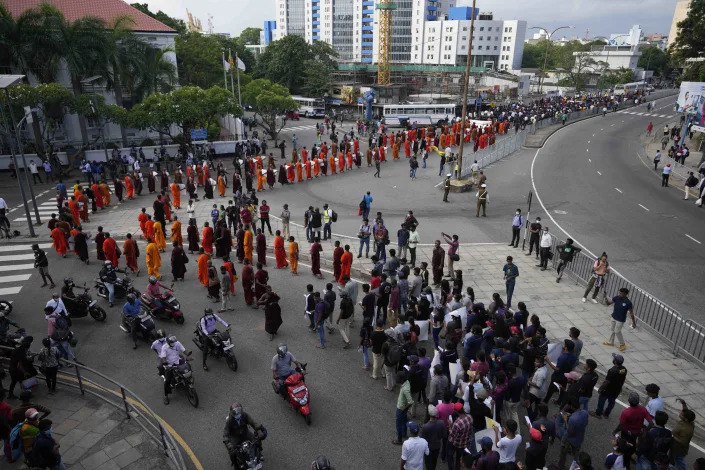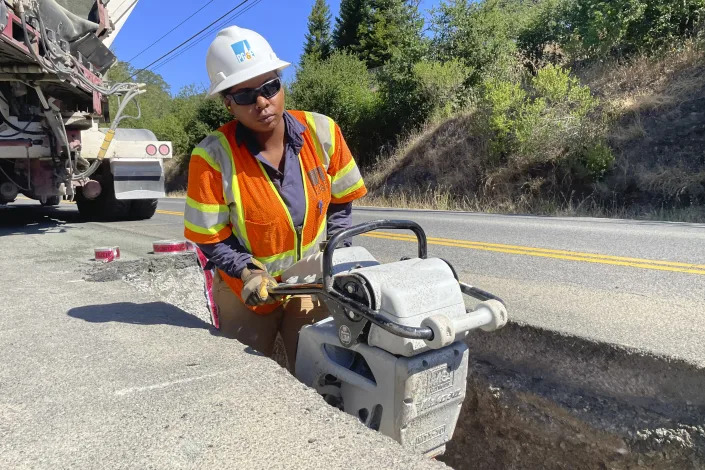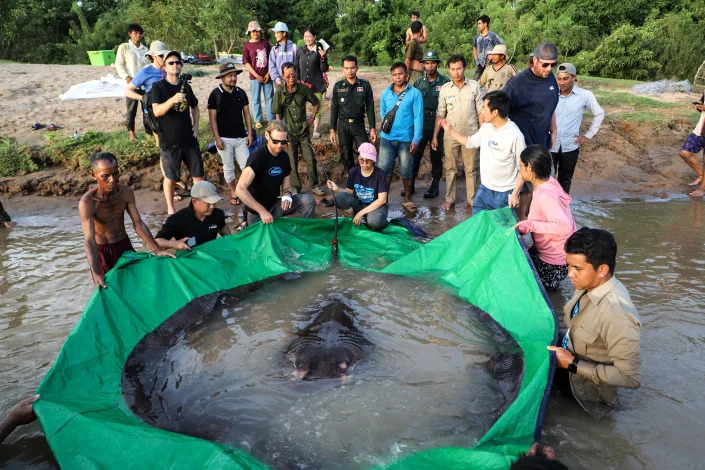FROM ONE HELL TO ANOTHER
Ten weeks after escaping Kabul, a women's rights activist found herself in Texas without food, money and three of her kids
Anna Schecter and Kenzi Abou-Sabe and Cynthia McFadden
Mon, June 20, 2022, 1:00 PM·9 min read
Roshan Mashal had been fighting for women’s rights in Afghanistan for more than a decade when the Taliban took over in August. Their lives in peril, she and 18 other prominent activists targeted by the Taliban were given seats on a flight and airlifted with their families out of Kabul. Their evacuation was arranged with the aid of women’s rights organizations and the State Department.
Ten weeks after she escaped to safety in the U.S. as part of the Biden administration’s Operation Allies Welcome, Mashal found herself out of food and money in a Texas apartment, with no access to health care or transportation and separated from three of her children.
Mashal, her husband and her children were among the more than 76,000 evacuees who poured into the U.S. after the Taliban took control of Afghanistan. Her family’s bumpy first year in the U.S. highlights the cracks in the resettlement system that have left whole families stuck in hotel rooms for months, overwhelmed by the paperwork needed to start their lives in America.
“We are struggling with this complicated system,” Mashal said. “There is one caseworker with 60 clients.”
The case worker at her local resettlement agency was swamped by Afghans needing assistance in the Dallas area. Most of the families had fled Afghanistan with only a single small bag, many not speaking English or knowing how to apply for Social Security or Medicaid or register their kids for school.
The Biden administration had instructed the departments of State and Health and Human Services to coordinate with 200 local resettlement agencies to help Afghans rebuild their lives here. But the system was so overwhelmed by the sheer number of refugees that the “welcome” many received was less than ideal. Mashal's family was just one of many that slipped through the cracks.
Texas was the unexpected endpoint of their harrowing journey from Kabul to America. The family’s first stop was at Fort McCoy, Wisconsin, a military base recast as a refugee camp for nearly 13,000 Afghans. For more than a month evacuees stood in long lines for food and clothing, and there was little privacy in the barracks.
Mashal asked that she and her family be resettled in the Washington, D.C., area, like other prominent activists, so she could continue her work on behalf of Afghan women. She said she was told her family of seven — her, her husband and five children — was too large to be resettled there. She said she was told that if she went to Texas, instead, the family could stay together.

Women's rights advocate Roshan Mashal, center, and Hillary Clinton receive awards from Refugees International, a nonprofit organization promoting human rights for refugees, on May 11. (Laurence L. Levin / Refugees International)
But she said that when she and her husband were abruptly put on a plane to Dallas, only her two youngest children were allowed to go with them. The three older children, all over 21, had to stay in Wisconsin. Two made it to Dallas in late October, and the third arrived in January.
Within 10 days of their having moved into an apartment north of Dallas, the groceries the resettlement agency provided Mashal had run out.
“In the camp they say we are working so that when you resettle you have your own apartment, food stamps, Medicaid, Social Security and work permit, but that’s not the case,” she said. Every member of her family, she said, experienced delays in getting social services.
Her son had an eye infection but was turned away from two clinics because he didn’t have Medicaid. A caseworker from the resettlement agency had to drive him to the emergency room for treatment.
Her husband, who asked not to be named in this article, didn’t get a work permit until February, four months after he arrived in Texas, Mashal said. He had been a member of the professional class in Kabul. In May he started working at a minimum-wage job.
Congress had passed an emergency funding bill that included $6.3 billion to help Afghans and resettlement agencies pay for housing and other basic services.
As part of the program, the federal government provided money to resettlement agencies for services for every evacuee, sometimes referred to as “welcome money.” But the welcome money ran out fast for many. Mashal said she soon had trouble buying her family food.
It also took until February, six months after her arrival in the U.S., for Mashal to receive the card she needed to buy food via the Supplemental Nutrition Assistance Program, the program once known as “food stamps.” But the first time she used it at a grocery store checkout counter, she learned it wouldn’t cover all her groceries. While she was grateful to be in America, she was frustrated by her struggle to care for her family.
It was a low moment, she recalled. “Morally, it was stressful and shameful.”
After Mashal told the resettlement agency about her family’s lack of food, she said, a caseworker started bringing supplies every 10 to 15 days. A local nongovernment organization, DFW Refugee Outreach Services, also distributed food to Afghan families several times.
Ultimately, Mashal was able to gather her children, arrange for food and health care and find employment. She has a one-year fellowship at the University of Texas at Arlington Women’s and Gender Studies program, which was arranged with the help of the Georgetown Institute of Women, Peace and Security and the Texas International Education Consortium. She is one of 16 Afghan women who have received fellowships through the Georgetown institute.

Roshan Mashal put photos of women in Afghanistan on the walls of her office at the University of Texas at Arlington. They are reminders of the ongoing struggle back home, she said. (Kenzi Abou-Sabe / NBC News)
For the first few months of the job, she commuted three hours each way by trains, a bus and an Uber to get to the university. She and her family have since moved to an apartment closer to work.
But the son who had an eye infection is still without Medicaid. Her 25-year-old daughter, who studied medicine in Kabul, doesn’t yet have papers that would let her work, even though the application process began back at Fort McCoy.
A State Department spokesperson declined to comment on Mashal’s family or any Afghan’s individual case, citing privacy considerations.
Mashal said she is concerned for Afghan refugees who don’t speak English and who don’t have connections to American NGOs as she does thanks to her years working alongside U.S. organizations to promote equality for women in Afghanistan.
“I worry about women and girls here. Many of them are illiterate and don’t understand the transportation system,” she said. “It is so different from Afghanistan. They need support.”
Chris George, the executive director of the Integrated Refugee and Immigrant Services resettlement agency in Connecticut, said resettlement agencies across the country struggled to do more with less for Afghan evacuees after they were weakened during the Trump administration.
“Many of them had closed down. And then, suddenly, we were asked to do something that was really unprecedented, which is to resettle 76,000 people in a matter of three or four months,” George said.
“There were too many cases, too many families coming in too short a period of time. We did the best we could. And in some cases, families suffered.”
Volunteers and veterans
During the chaos of the first months of Afghan resettlement, volunteers, NGOs and military veterans stepped in to help with the absorption of so many people with language and cultural barriers all needing help at the same time.
Retired Green Beret Matthew Coburn of Pennsylvania operated as a one-man resettlement agency for weeks as he assisted the evacuation of four Afghan commandos he’d fought alongside over multiple tours in Afghanistan.
But in an example of bureaucratic wire crossing, an able-bodied former Afghan commando whom Coburn helped to evacuate is still waiting for a work permit while the man’s baby son inexplicably received employment authorization in the mail.
“It has been chaotic, overwhelming and disorganized from the get-go,” Coburn said. “Once the resettlement agency got up to speed, it took a lot of the burden off me, but the government’s bureaucracy” — which provides things like employment authorization and Social Security cards — “still hasn’t caught up.”
At times tensions have bubbled up between unaffiliated volunteers trying to help Afghans and the refugee resettlement agencies tasked to do so.
In Iowa a volunteer group called Des Moines Refugee Support, which wasn’t officially part of the refugee resettlement agency network, started getting calls from desperate Afghan evacuees. The group stepped in to buy food and clothing and provide rides to doctor’s appointments. Volunteers asked local resettlement agencies for evacuees’ information to help fill out medical forms and register children in school. The group said two agencies refused, citing privacy concerns.
“There were kids sitting in hotel rooms for months, not registered for school, because they had no permanent address,” said Alison Hoeman, the founder of Des Moines Refugee Support, who said many of evacuees said they struggled to get enough food.
One of the Iowa resettlement agencies declined to comment, and the other didn’t respond to a request for comment.
Mashal’s resettlement agency also didn’t respond to a request for comment.
Women fleeing the repression of the Taliban, like Mashal, have also gotten specific help from volunteers and NGOs. As the Taliban closed in on Kabul, Mina’s List, an NGO that helps women run for office in places around the world where women are marginalized, realized the U.S. government was focused on evacuating military contractors who had helped U.S. armed forces.

Roshan Mashal, center, leading a march for women’s rights in Afghanistan before the U.S. withdrawal from the country. (Courtesy Roshan Mashal)
“Just knowing the demographics, we realized those are mostly men,” said Teresa Casale, the executive director of Mina’s List, who helped flag Mashal and other female human rights activists to the U.S. government as being at risk.
A majority of Afghan evacuees are male, and the majority of Afghan women who made it to the U.S. are dependents, according to NGOs that work to support the evacuees.
“I do believe that the U.S. government’s overall approach did fail Afghan women and Afghan women leaders in particular. Everything from the peace process to the withdrawal to evacuation and resettlement,” Casale said.
The next hurdle for Mashal will be to clear the way to live and work here legally once the two-year grace period ends for Afghans who came to the U.S. as humanitarian parolees. She and her family are applying for asylum, but the system is backlogged, and it could take years.
“Every day all I think about are the people left behind in Afghanistan,” she said. “I am committed to continue my work fighting for women and human rights. I will never accept the Taliban’s ideology for women and girls and will continue our struggle.”

































